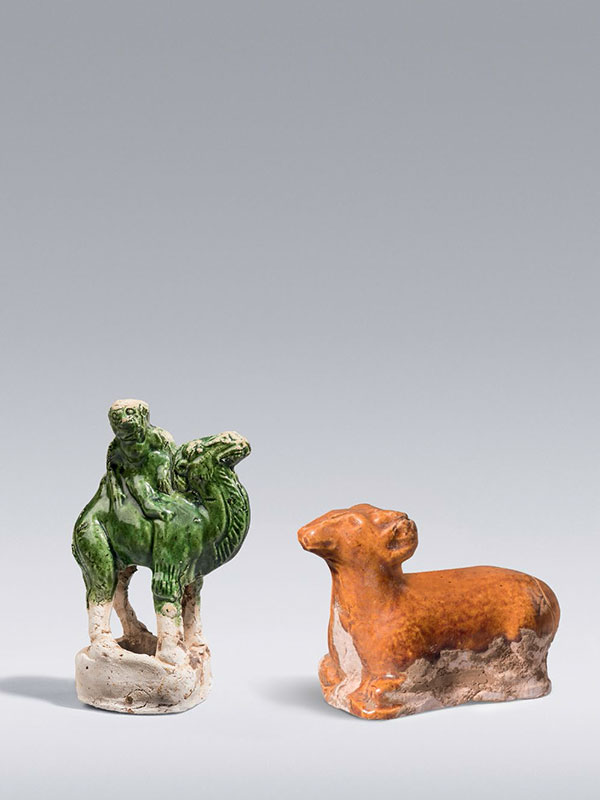Miniature pottery ram and camel
Two miniature pottery figures, one representing a seated ram, the other a camel with rider. The ram has its four limbs tucked underneath its body and a horned head looking straight ahead in alert position. The other figure depicts a rider seated on the back of a camel, his upper body turning towards his right. The camel stands still with its four legs separately modelled, its arched neck raised and its head looking straight ahead in an alert manner. The exterior of the ram is covered with a layer of lustrous amber glaze, stopping unevenly around the lower part of the body, revealing the fine buff pottery body. The camel and rider are covered with a layer of lustrous green glaze, also stopping unevenly around the lower part of the body and revealing the fine buff pottery body.
The ram (yang) was an important animal in ancient China, especially to the nomads to whom it provided both wool and meat. It is also one of the twelve animals of the Chinese lunar calendar. Its homophone yang is very auspicious, referring to both the sun and the masculine or positive principle in nature (yin/yang), hence the ram came to represent both meanings. [1] Two closely comparable small Tang pottery rams, in similar seated position and covered with a straw-coloured glaze, are respectively in the collections of the Shaanxi Provincial Museum [2] and the Victoria and Albert Museum. [3] Pottery groups of a camel with rider are not uncommon during the Tang dynasty, but miniature forms such as the present example are comparatively rare. A pottery standing camel, covered with sancai three- coloured glaze, is in the collection of the Idemitsu Museum of Arts, Tokyo. [4] Two further comparable small camels in reclining position, covered in amber glaze and perhaps deriving from the same mould, are in the Meiyintang collection. [5]
- Welch, P. B. Chinese Art – A Guide to Motifs and Visual Imagery, Tuttle Publishing, Singapore, 2012, p. 130
- Li, Zhiyan et al. Tang San Cai, Shanghai ren min mei shu chu ban she, Shanghai, 1988, no. 79
- Victoria and Albert Museum online collection archive, museum number: FE.161-1974
- Koyama, Fujio, Chūgoku tōji, Idemitsu Bijutsukan, Tokyo, 1970, no. 381
- Krahl, R. Chinese Ceramics from the Meiyintang Collection, Vol. Three (I) Paradou Writing, London, 2006, no. 1176, p. 168

